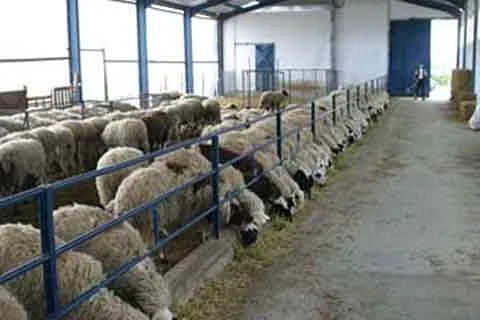BY DR. ZUBAIR AKHOON and DR. MUZAFFAR SHAHEEN
In the spurt of ongoing crash semi intensive animal farming and dairying for prompt economic booms, poultry farming, mutton purpose sheep and goat farming other than dairy farming is receiving scientific impetus all over the globe especially in India like Agro-rural nations which form the boon of Agriculture economy.
Drugs are used in veterinary medicine to prevent or treat animal diseases. When rationally administered to livestock following Good Veterinary Practices (GVP), they greatly contribute to improving the production of food of animal origin. Since humans can be exposed chronically to veterinary drugs through the diet, residues in food are evaluated for effects following chronic exposures.
Parameters such as an acceptable daily intake, the no-observed-adverse-effect level, maximum residue limits (MRLs), and the withdrawal periods are determined for each drug used in livestock. Drug residues in food exceeding the MRLs usually appear when failing the GVP application.
Different factors related either to the treated animal or to the type of drug administration, and even the type of cooking can affect the level of residues in edible tissues. Residues above the MRLs can have a diverse negative impact, mainly on the consumer’s health, and favor antimicrobial resistance (AMR).
Drug residue monitoring programmes are crucial to ensure that prohibited or authorized substances do not exceed MRLs. Infections account for some of the most significant diseases worldwide, both in animals and humans. Moreover, the appearance of new diseases has become inevitable.
The COVID-19 pandemic is the most recent infectious disease pandemic to emerge at the human–animal–environment interface, but it is not the first time an unknown or novel virus has developed from close contact between humans and wildlife. Viral, fungal, parasitic, or bacterial-mediated infectious diseases remain a significant threat to animal production and cause large deficits to the livestock economy.
Therefore, effective control is essential for the profitability of intensive livestock production. In addition, the growing world population increasingly demands affordable sources of protein from food animals and animal products, requiring improvements in livestock health care. In this context, it is evident that animal food supply will continue to rely on the use of drug-based therapies.
Veterinary drugs are chemical agents used to prevent or treat animal diseases as in humans. Rationally administered to food-producing animals, following Good Veterinary Practices (GVP), these favour the production of abundant food; meat, milk, eggs, and honey.
In contrast, several adverse effects, such as drug residues in food exceeding safe levels for humans, may appear when GVP standards are not met. Consequently, one of the essential principles prescribed by the international legislation is that foodstuffs obtained from food animals treated with veterinary drugs must not contain levels of residues either of the parent molecule or its metabolites that pose a risk to the consumer’s health.
Focusing on drug residues in food-producing animals, antibacterial and anti-parasitic compounds are among the chemicals with the most outstanding involvement in animal production due to the magnitude of their use.
In fact, because of the high economic impact and the direct repercussion on animal health, anti parasitic drugs currently represent, after biologicals, the second-largest position (23% of market share) in the world animal health market. Antibiotics rank third with 16% of sales.
The pharmacotoxicology and the patterns of tissue residues of different drugs used in livestock production thus assume tremendous importance.
This comprehensive work based on genuine survey- research in Kashmir at SKUAST-K of its first kind addresses some aspects of Xenobiotic residues in edible tissues like mutton chicken and milk produced for human consumption and provides relevant information contributing to the people’s awareness in the light of WHO “One health” paradigm. The work is briefly summarized here.
Two most commonly used anthelmintics drugs including Ivermectin and Fenbendazole and four frequently administered antimicrobials to livestock including Tetracycline Oxytetracycline Enrofloxacin and Ceftriaxone in the management of livestock health across the valley got included in the study for their residues in market milk mutton and chicken from different sources.
Milk from various local shops and vendors, different small dairy farms and pasteurized packed milk samples was found absolutely free of any of the above antibiotic residues but had traces of Ivermectin (6.67%) and Fenbendazole (10%) cases.
However pasteurized milk was free of any residues perhaps accounted to heat treatment. The mutton from local sheep detected only Enrofloxacin in 10% cases and anthelmintics like Fenbendazole residues in 10% cases, while the mutton imported from outside state detected residues for Ceftriaxone in 5% and Fenbendazole in 2.5 % samples.
The chicken flesh samples from some local poultry farms had 10% oxytetracycline 6% Enrofloxacin and 10% Ceftriaxone residues detected. None of the chicken meat had anthelmintics residues.
In nut shell it can be summarized that in all three livestock origin food components milk mutton and Chicken, 90% samples were safe for human consumption where as in rest of the 10% cases it was highly probable that proper withdrawal time period post drug administration (12-36 hrs) was not allowed before the edible animal product entered the market.
Moreover the further heating and cooking process is presumed to reduce the drug residue menace thereof.
Note: Deptt. of Food Technology Kashmir University is duly acknowledged for kind cooperation.
Dr. Zubair Akhoon, Asstt. Professor. Dr. Muzaffar Shaheen, Prof.and Head Clinical Medicine SKUAST K.
DISCLAIMER: The views and opinions expressed in this article are the personal opinions of the author.
The facts, analysis, assumptions and perspective appearing in the article do not reflect the views of GK.






